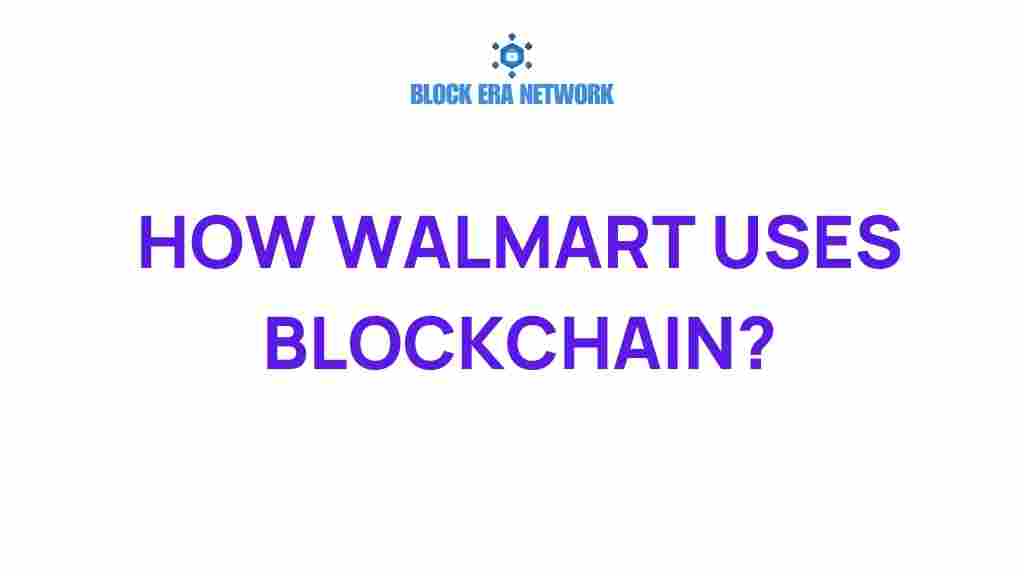Unlocking Transparency: How Walmart Uses Blockchain to Revolutionize Supply Chains
In an era where technology is reshaping industries, Walmart stands at the forefront of innovation in retail and supply chain management. One of the most significant advancements has been the adoption of blockchain technology. By leveraging blockchain, Walmart is enhancing transparency, improving traceability, and ensuring food safety throughout its supply chain. This article explores how Walmart is utilizing blockchain to revolutionize supply chains, focusing on transparency, technology, and innovation.
Understanding Blockchain Technology
Blockchain is a decentralized digital ledger that records transactions across many computers. This technology is known for its security, transparency, and immutability. Each block in the chain contains a number of transactions, and once a block is completed, it is added to the chain in a linear, chronological order. This creates a permanent record that is accessible to all parties involved.
In the context of supply chain management, blockchain provides a way to track products from the point of origin to the final consumer. This capability is crucial for industries like retail and food, where transparency and accountability are paramount.
The Need for Transparency in Supply Chains
Transparency in supply chains is essential for several reasons:
- Consumer Trust: Customers today demand to know where their products come from and how they are made. Transparency builds trust.
- Food Safety: In the food industry, the ability to trace products quickly can prevent widespread health crises.
- Regulatory Compliance: Many regions require detailed reporting on product sourcing and safety standards.
The integration of blockchain technology allows Walmart to address these needs effectively, making it a leader in retail innovation.
Walmart’s Blockchain Journey
Walmart began exploring blockchain technology in 2016, aiming to improve its food safety practices. The initial goal was to enhance the traceability of food products, particularly in the wake of foodborne illness outbreaks. The company partnered with IBM, leveraging the Hyperledger Fabric blockchain to create a solution that would allow them to trace the origin of products quickly.
Here’s a step-by-step process of how Walmart uses blockchain in its supply chain:
1. Product Tracking
Walmart uses blockchain to track products from suppliers to stores. Each product is assigned a unique digital identity that records every transaction, including:
- Farm origin
- Processing facilities
- Distribution centers
This chain of information is accessible to Walmart and its suppliers, allowing for real-time updates and tracking.
2. Data Sharing
Blockchain enables seamless data sharing among all stakeholders in the supply chain. This collaboration enhances visibility and accountability, ensuring that all parties have access to the same information. Walmart’s suppliers can update the blockchain with relevant data, such as:
- Harvest dates
- Transportation details
- Storage conditions
3. Rapid Recall Capabilities
In the event of a food safety issue, Walmart can quickly identify and isolate affected products. By analyzing the blockchain, the company can trace the product’s path and determine its origin within seconds. This rapid response is vital in minimizing the impact of foodborne illnesses, protecting consumers, and reducing waste.
4. Consumer Engagement
Walmart is also looking to enhance consumer engagement through blockchain technology. By providing customers with access to product information via QR codes, shoppers can learn about where their food comes from, how it was produced, and any certifications it has received. This level of transparency fosters trust and loyalty among consumers.
Benefits of Blockchain for Walmart’s Supply Chain
The implementation of blockchain technology in Walmart’s supply chain has yielded numerous benefits:
- Enhanced Transparency: All stakeholders have access to the same data, promoting trust and collaboration.
- Improved Traceability: Products can be traced back to their source quickly, ensuring accountability.
- Increased Efficiency: Automated data sharing reduces paperwork and speeds up processes.
- Strengthened Food Safety: Rapid recall capabilities minimize health risks to consumers.
- Consumer Empowerment: Customers have greater access to product information, leading to informed purchasing decisions.
Challenges and Troubleshooting Tips
While Walmart’s integration of blockchain technology has been largely successful, there are challenges that come with implementing this innovative solution:
1. Data Quality and Standardization
For blockchain to be effective, the data entered must be accurate and standardized. Inconsistencies can lead to confusion and errors.
- Tip: Establish clear guidelines and standards for data entry among all supply chain partners.
2. Technology Adoption
Not all suppliers may have the technology or knowledge to integrate with Walmart’s blockchain system.
- Tip: Provide training and resources to help suppliers understand and adopt blockchain technology.
3. Regulatory Compliance
As a global retailer, Walmart must navigate various regulations regarding data sharing and consumer privacy.
- Tip: Stay informed about local regulations and ensure compliance to avoid legal issues.
Future of Blockchain in Walmart’s Supply Chain
As blockchain technology continues to evolve, Walmart plans to expand its use beyond food safety. Potential future applications include:
- Pharmaceutical Supply Chains: Ensuring the authenticity and safety of medications.
- Financial Transactions: Streamlining payments and reducing fraud.
- Sustainability Tracking: Monitoring environmental impact and compliance with sustainability initiatives.
The continuous innovation and technological advancements in blockchain present exciting opportunities for Walmart to enhance its supply chain further.
Conclusion
Walmart’s adoption of blockchain technology represents a significant shift in how the retail giant approaches supply chain management. By focusing on transparency, traceability, and food safety, Walmart is not only improving its operations but also setting a new standard for the retail industry. The integration of blockchain technology is a testament to Walmart’s commitment to innovation and excellence in serving its customers.
As Walmart continues to unlock the potential of blockchain, it paves the way for a more transparent and efficient supply chain, ensuring that consumers can trust the products they purchase. For more insights on blockchain technology and its applications in retail, check out this resource.
For those interested in exploring the challenges and solutions associated with blockchain implementation, you can find additional information here.
This article is in the category Blockchain Basics and created by Block Era Network Team
